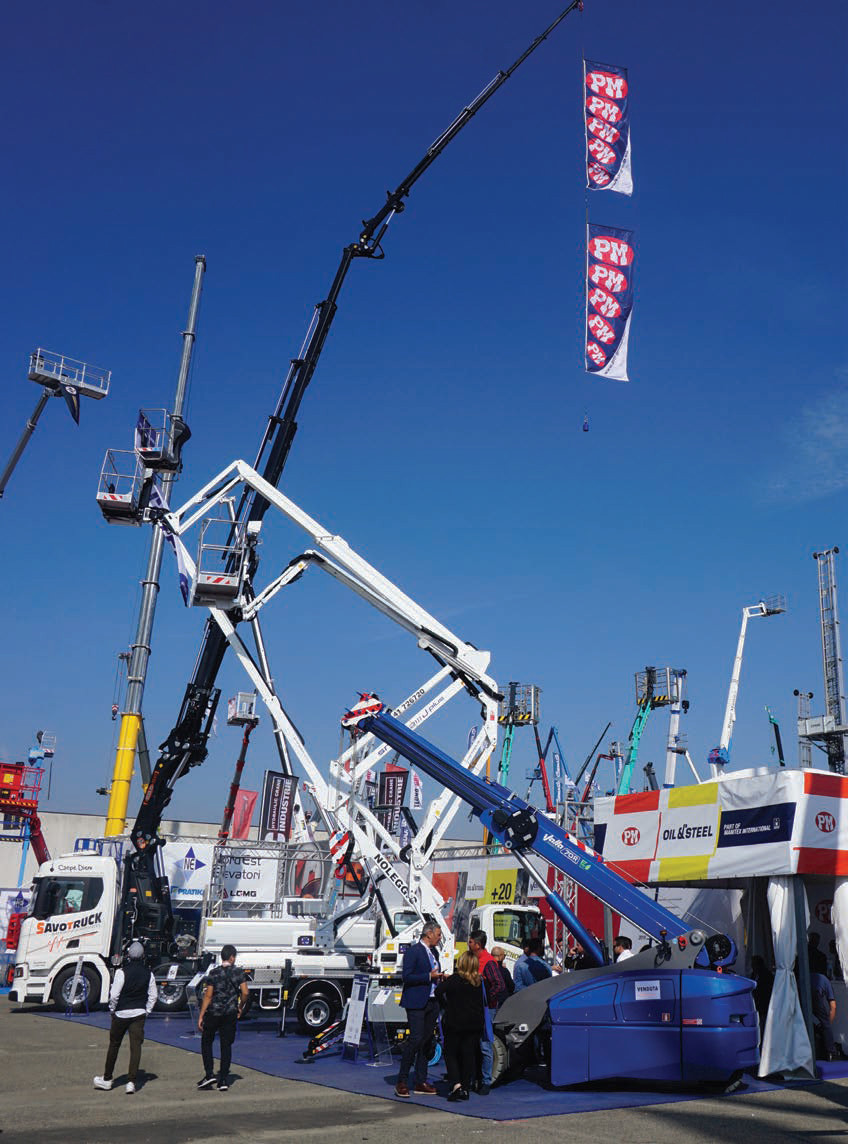Built in Italy
15 November 2019GIS in Piacenza has established itself as the key show for the Italian lifting industry. Will North attended, and spoke to a number of Italian—and Italy-based—crane manufacturers.
The Italian lifting industry has faced a tough few years. Locally, investment in construction, both public and private, remains slow.
While the small scale of many Italian manufacturers has, perhaps, somewhat limited their ability to bounce back from the ten-year hangover of the global financial crisis, the country still boasts a diverse range of crane companies.
At GIS, I spoke to a number of these companies, and found a wealth of innovation, and many crane builders pursuing highly specialised niches.
GIS is itself a good example of a show that is increasingly popular with crane buyers, distributors, and manufacturers. It brings together a focussed audience, in a show ground that is easy to get around. It doesn't aim to be Bauma, but to serve its market well. As it gets bigger, the challenge will be to retain this charm.
A new Italian all Terrain
Since 2008, Zoomlion, has owned Cifa, a leading concrete pump and truck mixer manufacturer with three plants in Italy, and subsidiaries in France, Germany and United States.
When it comes to lifting equipment for European customers, the company’s strategy, European sales manager Davide Simone says, “Is to manufacture locally what needs to be offered locally. This is the only efficient way to really understand and meet the market requirements and technological demands coming from each country in Europe.”
In line with this strategy, Cifa has been appointed as the “technological-hub” to develop and launch in the European market Zoomlion-branded mobile cranes. The first outcome of this project is the development of two brand new mobile cranes, totally engineered and manufactured in Italy with premium European components. These prototypes have been designated the ATC 960 and ATC 1000, in line with their provisional load charts. The former, on show at GIS, is a 60t three-axle all terrain; the latter will boast a lifting capacity of 100t and a 48m boom on four axles.
The machines represent the technological state-of-the-art, Simone says, and have appeared for the first time as prototypes at Bauma in Munich and more recently at GIS. Currently the units are under homologation; they will be available for purchase in the third quarter of 2020. New rough terrain and all terrain cranes are in the pipeline for development in 2020.
This first step in Europe is a milestone for Zoomlion as it aims to transform itself into a global player, entering into a mature market with a relative limited number of manufacturers. The group sees this, Simone says, as a long term project. The aim is to invest not just in sales to European customers, but rather to establish a manufacturing plant, R&D and aftersales departments in Italy. This means that European customers will benefit from local aftersales and maintenance support, as the company builds a solid network of local support in Europe.
Last but not least, Zoomlion customers will benefit from the chance to be supported by Zoomlion Capital Italy, a dedicated financial company that will offer unique financial services, such as long-term renting and leasing, on an exclusive basis.
Italian-American
Terex's crane business dates back to the turn of the millennium. In recent years, the US business has pursued a strategy of focus-andsimplify. This has seen much of the company's crane business sold off or wound down. Now, with the exception of Franna, the company's crane business is wholly Italian.
Marco Gentilini has been with the company since 2000, starting off as general manager of the former Bendini rough terrain business in Crespellano. Today, he heads up both that rough terrain business, and tower cranes in Fontanafredda.
Shortly after GIS, the company launched three new tower cranes, including its first hydraulic luffer (see p21). At GIS, the company showed a new range of rough terrains.
Gentilini acknowledges that the Demag brand, and Zweibrücken's record of design excellence, brought something special to the Terex mobile crane line. But, at the same time, this meant that Terex's rough terrain lines were somewhat overshadowed. Now, with Demag sold, he aims to bring a new focus to the rough terrain business.
In Europe, and around the world, Terex will be selling a new range of rough terrains. These are an entirely new line, building on the heritage of Bendini and Terex Italia. They boast Stage 5 engines, new cabins, and a range of upgrades.
Asked about investment in Italian infrastucture, Gentilini says he hopes to see new infrastructure projects launched in the near future. The rough terrain market, he notes has however been reasonably consistent. He expects no big upswing, but sees it as a bedrock for business. And, as he points out, Italian sales are not entirely dependent on the Italian market: often, they follow Italy's contractors to jobs in Africa, the Middle East and Asia.
It is on these markets—both in the EU and further abroad—that Terex will be focusing with its new rough terrain range.
That doesn't mean that the US is forgotten. North America, is after all, one of the biggest markets for rough terrains. The RT 100|US, while built in Italy, is a wholly US-focussed machine. It hits the sweet spot of the rough terrain market, at 100USt. It is supported by Terex's ongoing and established US service businesses, and the company is now building out a new sales division for North America. For the next Conexpo, a new global machine can be expected that will serve the worldwide market.
Terex's crane business may be smaller than it was, but it promises a new focus to go with its established expertise.
Remote control Trucks
In recent years, Fassi has developed a range of innovations in its control systems. As with many in the knuckleboom sector, this has been inspired in part by the 2011 revision to the relevant EU standard, EN 12999, which demanded the crane's stability function considers the installation as a whole. With FSC, Fassi Stability Control, the company brought a whole range of improvements.
The company's latest innovation is FX-Link, developed with Volvo Trucks Italy. This goes beyond just considering the stability of crane and truck together, to integrate the two machine's control systems: so, for example, an operator can view if the crane is correctly stowed while in the cab, or see the truck's fuel level on the crane's remote.
The next level of integration is to allow the crane operator to control the truck's movement from the crane remote control. This was launched at GIS, and drew a big crowd of onlookers to its demonstration.
Giovanni Fassi, CEO, explains that, while the idea originated in Italy, the company is already seeing international interest passed on from Volvo HQ. The system uses only components from Fassi and Volvo. That means, he says, that any customer who can buy a Volvo truck, can buy a Fassi crane mounted on a Volvo truck with the Drive by Fassi system installed.
Volvo designed the system to operate at up to 10mph. Bearing in mind the conditions on job sites, and the needs of the construction sector, Fassi has reduced this speed limit to 4mph: walking speed, essentially.
The efficiency advantages of such a system are clear: less time is lost to switching between cab and crane. For drivers who treat their cab as a home-from-home, it also reduces the need to jump into the cab with dirty boots, keeping their workplace cleaner and more comfortable.
Keep on Trucking
For many in the taxi crane sector, there is a growing gap at the bottom of the market. While there are still some smaller ATs, these now start at around 40t, and are generally higher capacity and higher tech than the job demands and—in many owners' view— higher priced than rental rates will support.
It's at this overlooked segment that Locatelli is aiming with its new TCL range of truck cranes. Sales manager Michele Mortarino points out that the costs of a small 'city' all terrain go beyond the initial purchase price: customers also need to consider the costs of commissioning such high tech equipment, servicing it, and training staff to operate it.
The new TCL range starts with the TCL 40.35. Since showing a prototype at Bauma, Locatelli has sold ten and delivered half of these.
The crane uses an upper very similar to that on Locatelli's established rough terrain cranes. That's good for the customer, as it keeps development costs down. Moving beyond RTs helps Localelli too, as its business is now less tied to the highly cyclical rough terrain market, which tends to rise and fall in line oil prices.
Locatelli developed a new LMI computer for the TCL cranes, with a 10in colour touchscreen, a user interface in several languages, and remote access. Just as the TCL uses boom technology developed for rough terrains, this system will now be transferred to the rough terrain line, in the first quarter of 2020. The company aims, Mortarino says, to give the operator and maintenance engineer a common feel across all of its cranes. Just as sharing technology keeps R&D costs and initial purchase prices down, so this common feel will keep training and service costs lower throughout the life of the crane.
But initial cost is not all. For the carrier on the the three-axle TCL 40.35, Locatelli chose a Mercedes Benz. For the next crane in the series, the four-axle TCL55.50, the company may choose a Scania carrier. But they will be reliable, popular, trucks with easily availability of parts and service. Outside of Europe, Locatelli could offer the choice of locally popular carriers from the likes of Tata and Maz.
Fits every Niche
JMG’s CEO Maurizio Manzini jokes that if a customer needs to ask what a crane costs, they’re not the right customer for him. But, when it comes to working in tight environments, Manzini says that if the customer can describe what they need, he can supply the crane. JMG’s cranes may be small, compared to those used in construction, but they are designed to pack as much lifting capacity as needed into as small a package as possible.
The first crane Manzini showed Cranes Today was impressive, but very much routine for a company like JMG: a cab-less radio remote control pick and carry crane, able to lift 18t, with front stabilsers to boost capacity, and a battery pack that could be charged overnight for a full shift working.
It's the new MC50000 RE that really astonishes with its ingenuity. The crane mounts a 50tm Cormach knuckleboom on a carrier suitable for use indoors. In itself, a useful device, but by no means unique. On most cranes like this, the crane would be mounted on top of the carrier.
JMG's genius is to mount the crane at the bottom of carrier: the slewing ring is at the base of the main steel structure, with a hole through large enough to accommodate the vertical column of the knuckleboom. This allows the crane to operate freely, but saves vital headroom when the crane is stowed. Unstowed, it offers all the lifting power and reach an industrial rigger could need.
The whole device weighs just 20t, including two 1t front and rear counterweight pieces, which can be removed by the crane itself.
Working together
A series of recent deals have given knuckleboom manufacturer PM, and related access brand Oil & Steel, new ways to reach customers around the world.
First, came Manitex's acquisition of PM, announced in 2014 and completed in 2015. Giovanni Tacconi, PM sales director, says, "It's been a positive change, it's a company in the same business. They are more of a global partner, particularly in the US and North American markets, with some exchange of technology and markets. Their position is to expand into the knuckleboom and platform business.
"For PM, the market in Italy is difficult. But around the world, we’re more active in North and South America, and Northern Europe."
A more recent deal further boosts PM's network. Last year, Tadano acquired 14.9% of Manitex, and this will open up further opportunities. Tacconi says, "We're starting a partnership to promote straight boom cranes in South East Asia and in the Middle East. We have a new range we are using to promote cranes with Tadano. These are PM cranes, built in Italy, with a PM Tadano logo, under the supervision of Tadano, in a full range of capacities."
PM already has a flourishing export business. Antonino Di Marco, marketing manager, previously worked on the company's Latin American business. He says, "For knucklebooms, Latin America makes up 25-30% of our market: Chile, Argentina, Colombia, Peru, Mexico. We support our customers there with customer service; we have support in Chile and Argentina, through direct subsidiaries. We also have dealers in Argentina. We have another branch in Mexico, and serve the other countries though dealers."
As the company builds its reach, so it is building its range. Valla is also now wholly owned by Manitex, but run as its own division. The company exhibited at GIS alongside PM. Its latest model, the 70R, is a 7t remote control pick-and-carry crane, which targets the press installation sector and moving of components in aviation and automotive manufacturing.
PM's latest range runs from 8.5–11tm, the key capacity class in Europe. All of these cranes have infinitely proportional LMIs, linked to the crane's outriggers, and the option of radio remote control.
At the same time, the company is looking to much bigger, 50- 100tm units, which will compete with smaller all terrains. And, in the USA, a new line of MAC, or Manitex Articulating Cranes, has been launched, which are distributed through the US straight boom sales network.
JIB Extension
F'lli Ferrari has been working to build its range across its line-up.
Francesco Fasano, export area manager, says, "We’ve invested a lot of money and time in a new range of crane, the articulated cranes typical for recover vehicles.
"The capacity for these is higher. But also, even for the smaller and medium range, we have improved the range. We’ve completely renewed the range, starting from 9tm, up to 66tm range, with a choice of rackand- pinion or endless rotation: for medium and bigger cranes, customers prefer endless rotation, and for smaller cranes, rack-andpinion."
Fellow export area manager Giorgio Tadioli, adds, "The most recent models are 60 and 66tm. They're a completely new design, not a restyling. It's a completely new project from the beginning."
Fasano says, "The customers are happy. For example we’ve just sold two or three of the new 66tm crane."
Tadioli continues, "There are several innovations with these new products, to make them more work effective. We're bringing several advantages, that are cost saving and time saving. The dynamical diagram shows capacity according to stabilisation. You can indicate weight and adjust the safe lifting area in real time.
"You know in advance where you can lift, clearly, around the truck. It can show you if you need to extend the stabiliser more, or if it is OK as it is.
"We’ve tried with the new line to standardise the components, with the same suppliers for distributor valves, motors, so it's easier for the dealer to have spare parts as needed.
"We try to be as close as possible to the customers, it’s important in Germany, and in Italy, to have a reliable workshop who know us and know the products, but are close the customer, so you can bring the best possible service.
"We have a new feature, Magic Touch, that offers automatic closing and opening of the crane, from any position. So you can have the crane in work or closing position immediately."
Fasano concludes, "There’s a lot of space in the range, that we are now covering with the new line. We’ve invested a lot in R&D."
 Ormig this year celebrated its 70th anniversary. At GIS, the company showed a broad spectrum of cranes across its line-up, both diesel and electric. The company has recently introduced a new line of electric cranes, as these become increasingly popular. The new cranes have very small dimensions: even the 60t model fits within a width of just 2.35m. All of the cranes can rotate on themselves, and can pick-and-carry at 100% of their capacity.
Ormig this year celebrated its 70th anniversary. At GIS, the company showed a broad spectrum of cranes across its line-up, both diesel and electric. The company has recently introduced a new line of electric cranes, as these become increasingly popular. The new cranes have very small dimensions: even the 60t model fits within a width of just 2.35m. All of the cranes can rotate on themselves, and can pick-and-carry at 100% of their capacity.
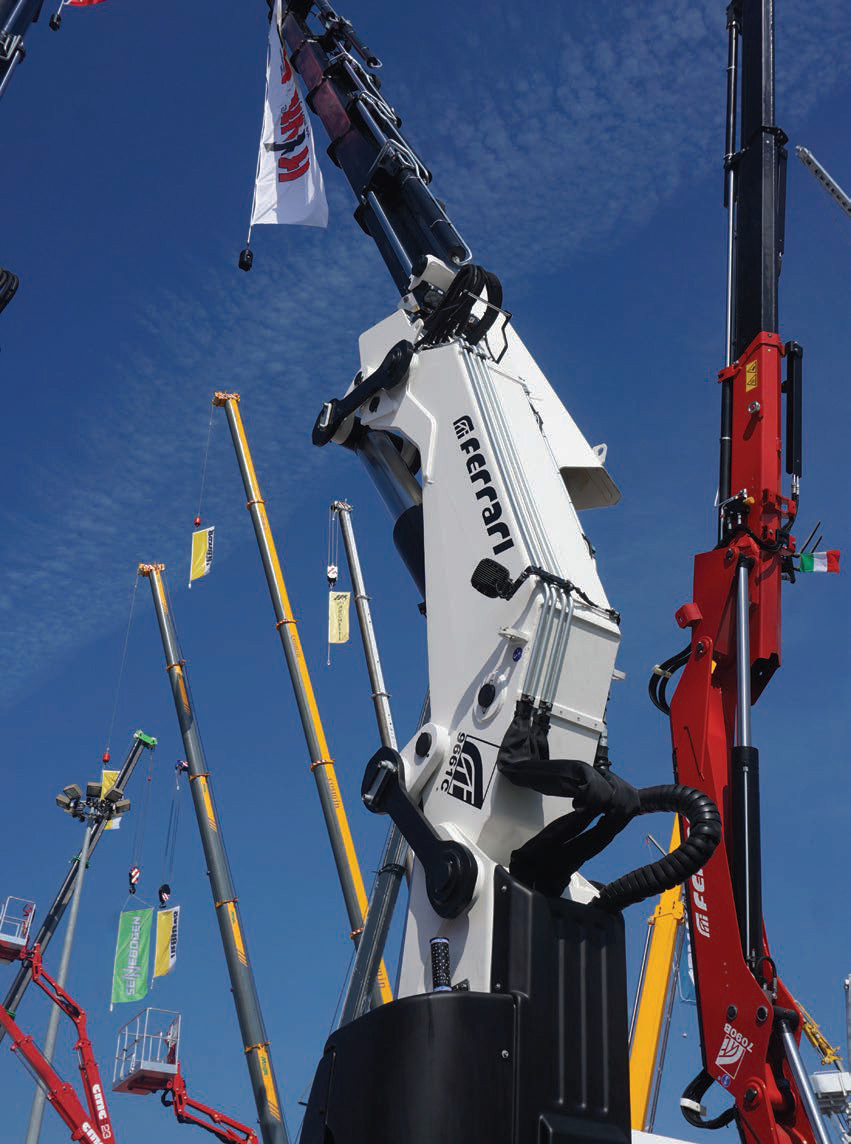 F'lli Ferrari is extending its range with new large recovery cranes, and a series of new models in the small-to-medium class.
F'lli Ferrari is extending its range with new large recovery cranes, and a series of new models in the small-to-medium class.
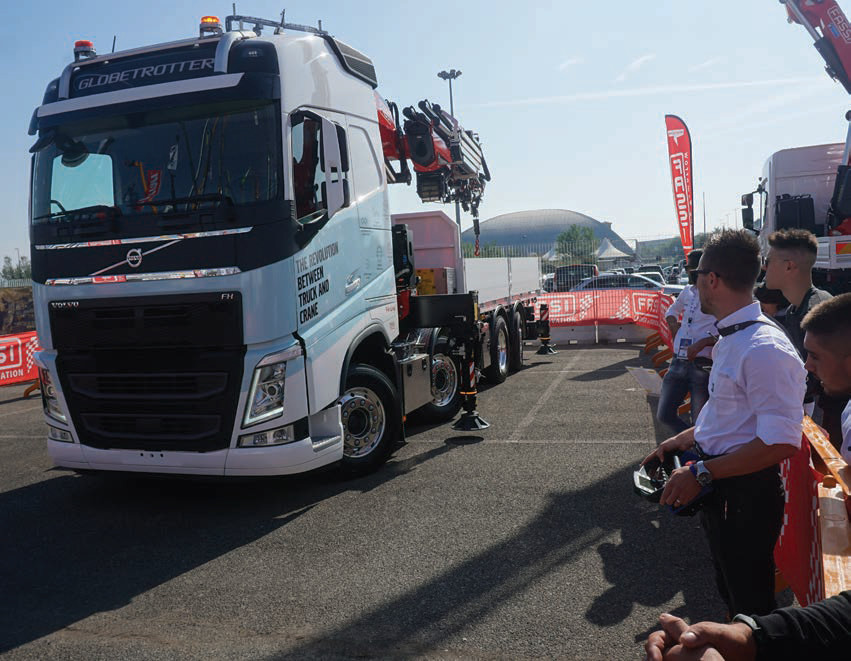 One of the biggest crowds of the show was drawn to Fassi's demonstration of its new Drive By Fassi system, a further development of its FX Link system, developed with Volvo Trucks Italy. The new system lets an operator control the truck by remote control, avoiding the need to get in and out of the cab on site.
One of the biggest crowds of the show was drawn to Fassi's demonstration of its new Drive By Fassi system, a further development of its FX Link system, developed with Volvo Trucks Italy. The new system lets an operator control the truck by remote control, avoiding the need to get in and out of the cab on site.
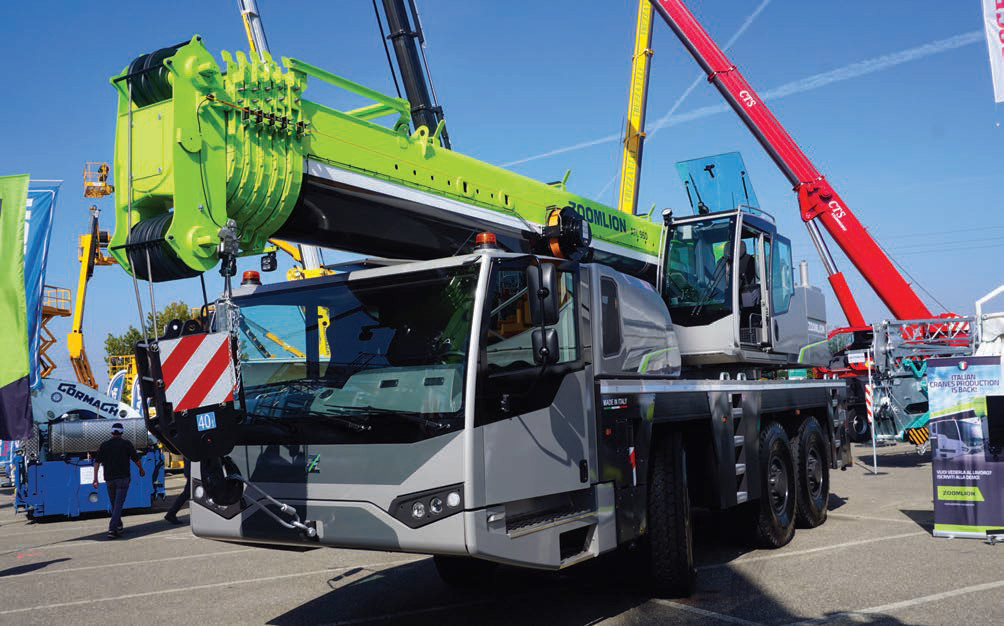 The 60t threeaxle Zoomlion ATC 960 on show at GIS. First shown at Bauma, this crane has been developed in Italy by Zoomlion-Cifa Europe, which has been appointed the technological hub for all of the company's European lifting equipment.
The 60t threeaxle Zoomlion ATC 960 on show at GIS. First shown at Bauma, this crane has been developed in Italy by Zoomlion-Cifa Europe, which has been appointed the technological hub for all of the company's European lifting equipment.
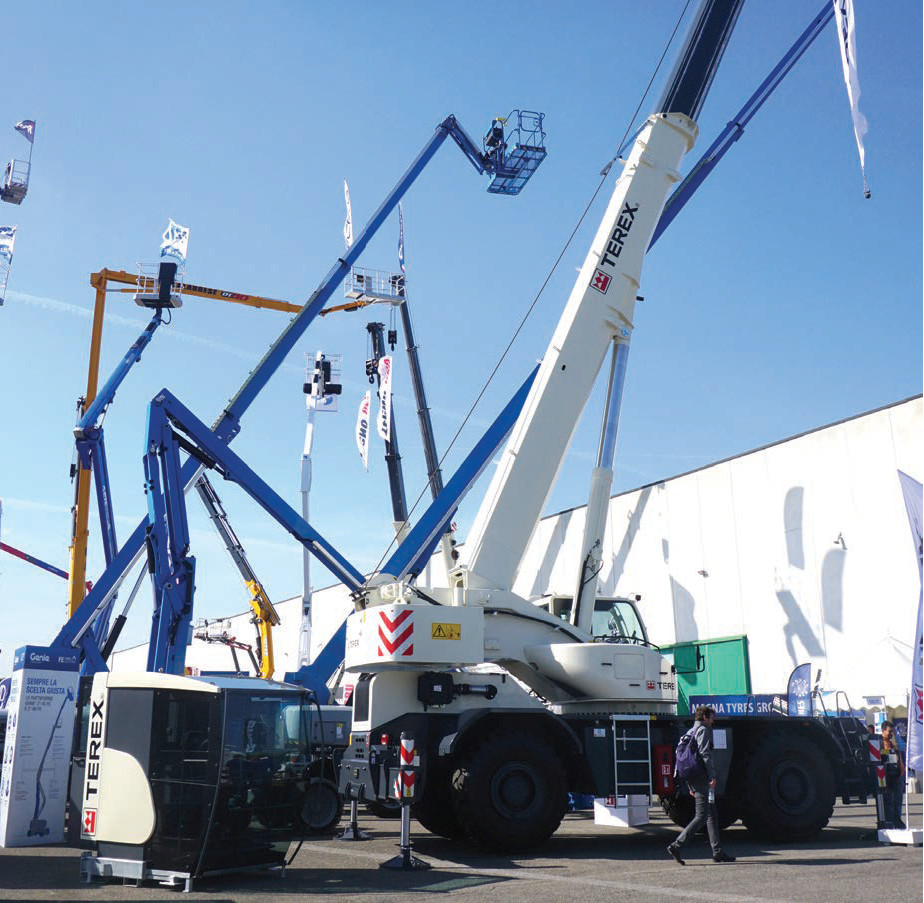 The bulk of Terex's crane business is now based at its tower crane plant in Fontanafredda, and its rough terrain plant in Crespellano. Both ranges were on show at GIS, with rough terrains and a cab from the tower crane line. A new range of tower cranes, including the company's first hydraulic luffer, was launched the week after GIS.
The bulk of Terex's crane business is now based at its tower crane plant in Fontanafredda, and its rough terrain plant in Crespellano. Both ranges were on show at GIS, with rough terrains and a cab from the tower crane line. A new range of tower cranes, including the company's first hydraulic luffer, was launched the week after GIS.
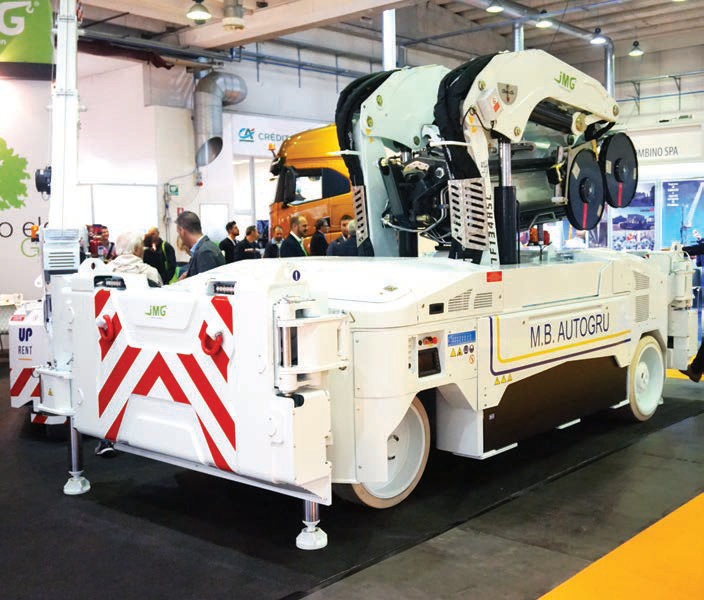 JMG showed a wide range of its highly-specialised pick and carry and indoor cranes. The most striking was the MC50000 RE, which mounts a 50tm Cormach knuckleboom at the base of the carrier, with the column passing through the structural steel, allowing for high capacity lifting that stows down into as small a device as possible.
JMG showed a wide range of its highly-specialised pick and carry and indoor cranes. The most striking was the MC50000 RE, which mounts a 50tm Cormach knuckleboom at the base of the carrier, with the column passing through the structural steel, allowing for high capacity lifting that stows down into as small a device as possible.
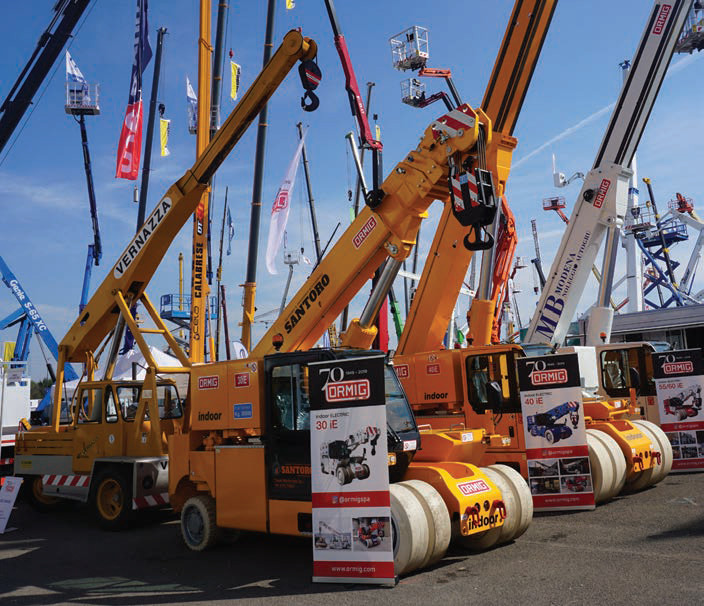 Ormig this year celebrated its 70th anniversary. At GIS, the company showed a broad spectrum of cranes across its line-up, both diesel and electric. The company has recently introduced a new line of electric cranes, as these become increasingly popular. The new cranes have very small dimensions: even the 60t model fits within a width of just 2.35m. All of the cranes can rotate on themselves, and can pick-and-carry at 100% of their capacity.
Ormig this year celebrated its 70th anniversary. At GIS, the company showed a broad spectrum of cranes across its line-up, both diesel and electric. The company has recently introduced a new line of electric cranes, as these become increasingly popular. The new cranes have very small dimensions: even the 60t model fits within a width of just 2.35m. All of the cranes can rotate on themselves, and can pick-and-carry at 100% of their capacity.
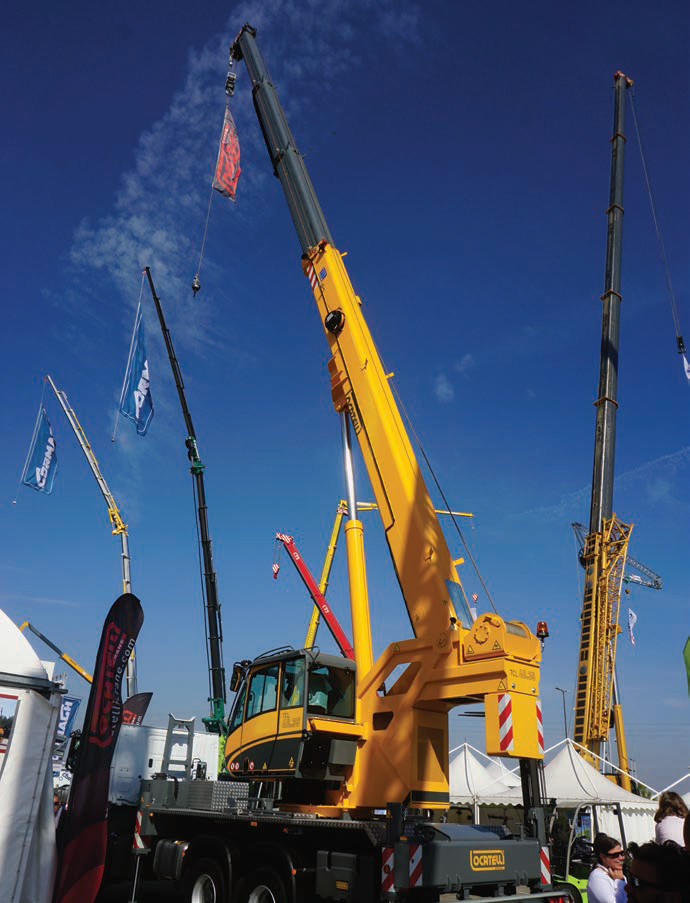 Locatelli is bringing a new line of cranes to an often-overlooked sector, of costeffective truck cranes. It has already sold ten of the first model, with five already delivered.
Locatelli is bringing a new line of cranes to an often-overlooked sector, of costeffective truck cranes. It has already sold ten of the first model, with five already delivered.
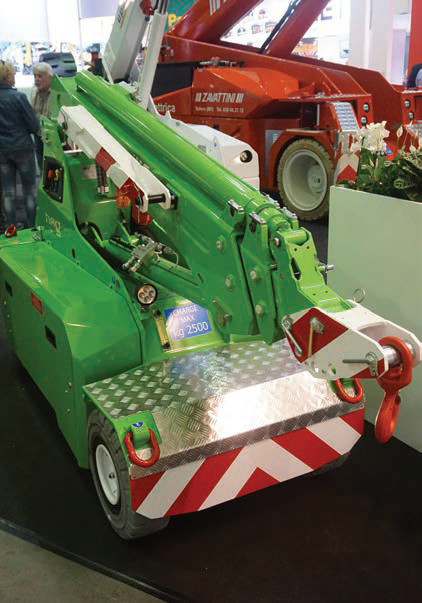 JMG showed a wide range of its highly-specialised pick and carry and indoor cranes. The most striking was the MC50000 RE, which mounts a 50tm Cormach knuckleboom at the base of the carrier, with the column passing through the structural steel, allowing for high capacity lifting that stows down into as small a device as possible.
JMG showed a wide range of its highly-specialised pick and carry and indoor cranes. The most striking was the MC50000 RE, which mounts a 50tm Cormach knuckleboom at the base of the carrier, with the column passing through the structural steel, allowing for high capacity lifting that stows down into as small a device as possible.
